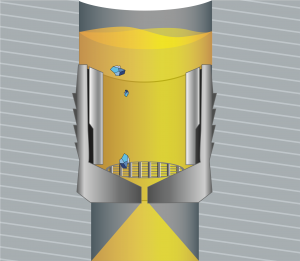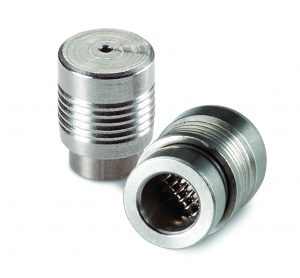SCREENED RESTRICTORS
DAMAGE PREVENTION, EMISSIONS CONTROL AND EFFICIENCY IMPROVEMENTS CAN BE ACHIEVED BY ALLOWING THESE COMPONENTS TO REDUCE DEBRIS IN FLUID SYSTEMS
Fluid contamination presents a growing concern for engineers in the automotive industry. Today’s designs rely on complex fluid systems to optimize performance and control emissions. While flow restrictors provide the precision fluid control needed, contamination in lubricant not only affects the performance of the flow restrictor, but can be detrimental to downstream components, parts and assemblies, often the most expensive to replace. By designing-in a screened flow restrictor, engineers can improve fluid cleanliness, protect systems and optimize designs, all while helping to meet performance targets.

While not a filter, screened restrictors help prevent contaminants – such as rubber, plastic, compounds and metal debris from circulating in a fluid system. These contaminants can damage components and affect performance, leading to warranty costs and reduced efficiencies. The permanent addition of the screened restrictor not only precisely controls the flow rate, but it also helps to ensure prolonged circuit functionality and fluid quality. Engineers are increasingly looking to these parts to provide performance gains and design changes that help meet emission targets and efficiency goals.
“Screened KOENIG RESTRICTOR® solutions are an effective tool for many of our automotive customers. We’ve worked on applications where they are used in diesel exhaust dosing – helping to reduce harmful NOX emissions – as well as a critical component within an all-wheel drive disconnect system – which increased fuel efficiency by regulating when a vehicle would be driven by two wheels instead of four, depending on road conditions,” said Nathaniel Moore, Product Manager for SFC KOENIG®. “The push to meet ever-expanding and more exacting global standards means we are continuously finding new opportunities to leverage the benefits of a screened flow restrictor.”
Parts reduction is an effective method to achieve lighter weights. Often times within a fluid circuit, there may be a component or a sub-system which cannot handle the volume of flow that the rest of the circuit operates on. By permanently reducing the flow rate with a screened restrictor, the same circuit can be used for lubrication, eliminating the need for a separate circuit and/or additional components, such as pumps.

“Engineers know SFC KOENIG parts for their proven reliability, precise flow control and fast, easy installation even in high-speed manufacturing environments,” said Moore. “With our one-piece screened restrictor design they get all those benefits, and it allows one small component – between 4 to 10mm in outer diameter – to potentially eliminate the need for large system components or additional independent circuits.”
While the screen itself helps to eliminate contamination in the fluid, since KOENIG RESTRICTOR solutions do not require thread machining, reaming, sealants or adhesive compounds, they also do not create any additional contamination.
To achieve the desired flow rate, as well as eliminate fluid debris, it is typically recommended one work directly with the screened restrictor manufacturer, as there are a wide variety of considerations to each application.
“Though screens in the 125-micron range are often utilized, our recommendations are really based on thorough knowledge of their requirements,” continued Moore. “Base material, fluid medium, pressure, temperature and operating conditions affect the flow rate and impact of the screen. We work with customers to help develop the screened KOENIG RESTRICTOR solution, and even to provide a sealing solution for the same circuit, if needed. Our company’s global operations really help customers achieve their goals – no matter where they are located. That, combined with our advanced flow testing capabilities, allows engineers to achieve even greater results, knowing their system is optimized down to the component level.”
By designing-in a screened flow restrictor, engineers are realizing performance benefits, as well as new opportunities to improve efficiency and reduce emissions.
Learn more about our standard orifice flow restrictor models as well as our custom solutions, or contact us and speak to our engineering team about your application. Our flow control experts can develop a screened flow restrictor for your specific requirements.
single.php
